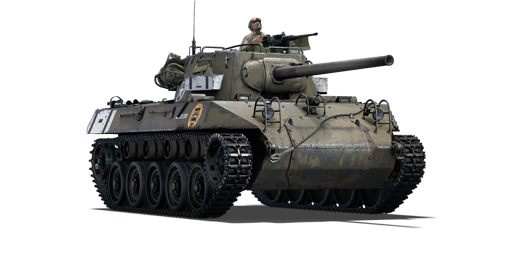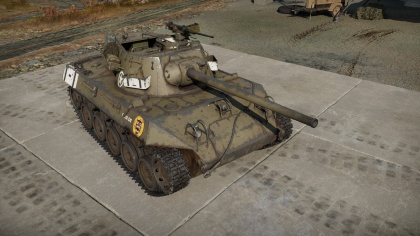"Racing" M18
Contents
Description
The "Racing" M18 is a gift rank III American tank destroyer
with a battle rating of 4.7 (AB/SB) and 5.0 (RB). It is a version of the M18 "Black Cat" customised for racing in the occasional Racing events alongside the Po-2 Night Witch, lacking any form of armament. It has never been obtainable for use outside of the race events.
General info
Survivability and armour
Armour type:
- Rolled homogeneous armour
- Cast homogeneous armour (Gun mantlet)
| Armour | Front (Slope angle) | Sides | Rear | Roof |
|---|---|---|---|---|
| Hull | 12.7 mm (39-64°) Front glacis 12.7 mm (23-52°) Lower glacis |
12.7 mm (23-26°) Top 12.7 mm Bottom |
12.7 mm (12°) Top 12.7 mm (36°) Bottom |
8 mm |
| Turret | 25.4 mm (15-26°) Turret front 19 mm + 25.4 mm (0-55°) Gun mantlet |
12.7 mm (1-21°) | 12.7 mm (7°) | N/A Open-top 8 mm Bustle and Front |
Notes:
- Suspension wheels and tracks are 15 mm thick.
- Belly armour is 5 mm thick.
- The hull underside right above the tracks are only 8 mm thick.
- Tracks are attached the the turret rear, granting some 15 mm in thickness.
Mobility
| Game Mode | Max Speed (km/h) | Weight (tons) | Engine power (horsepower) | Power-to-weight ratio (hp/ton) | |||
|---|---|---|---|---|---|---|---|
| Forward | Reverse | Stock | Upgraded | Stock | Upgraded | ||
| Arcade | 113 | 37 | 17.7 | 653 | 2,290 | 36.89 | 129.38 |
| Realistic | 104 | 34 | 407 | 1,200 | 22.99 | 67.8 | |
The M18 is dangerously quick and agile. With its high top speed and acceleration, it can easily become a speed machine in the hands of a skilled driver. However, rough driving can cause it to become uncontrollable, so crashes and pileups are a regular occurrence on the race track.
Armaments
Due to being designed solely for racing, the M18 does not feature any functioning armament, which is probably for the best so as not to add to the ensuing chaos of a pack of M18s vying for the lead on a crowded circuit.
Usage in battles
The key to winning in the M18 is to go fast, and stay fast. Since your only opponents will be in the exact same vehicle as you, the race is decided in how well you can handle corners, and how little you crash. Take corners with care, but don't be overly cautious. The tracks allow you to abuse physics in a way that typical race cars could only dream of attempting, but the light weight often causes the tank to veer violently out of control in a turn. Use the terrain to your advantage, but avoid traversing rough ground at high speeds. Racing is an artful balance of speed and strategy.
Pros and cons
Pros:
- Fast
- Low profile
- Good power to weight ratio
- Very fast reverse
Cons:
- None, it's everything you could want for an exhilarating race around Berlin
History
US Tank Destroyer Doctrine
The anti-tank doctrine established by the US military called for fast, powerful vehicles able to stop the German blitzkrieg tactics by ambushing the attacking tank forces. Unlike the other armoured fighting vehicles in the theatre, the tank destroyers were made to be placed in reserves to counter any breach in the front lines by taking out the enemy with ambushes. This role led to the desire for a fast vehicle with a powerful gun, the armour was not a concern due to the emphasis in speed. The initial response was the M10 GMC, made form the Medium Tank M4 Sherman hull and mounting a 3-inch M1918 gun. While adequate at this role, it was no faster than an ordinary Sherman tank. The M18 GMC was a response to the problem to provide the tank destroyer force with a very fast tank destroyer.
Development
The origin of the M18 GMC design came as early as December 1941 with the requirement of a Christie suspension and a 37mm gun. This requirement called for a radical new tank design rather than a derivative of the M4 Sherman. These requirements changed as the war progressed, the first change was to the new and innovative Torsion bar suspension from Buick Motor Division from General Motors and another change was to mount the British QF 6-pounder gun then in use on their Churchill Mark III tanks, the developed prototype vehicle was called the T49 GMC. Then the army wanted the heavier 75mm gun used on the Shermans on it, this prototype was designated the T67 GMC. Finally, the army decided to mount the 76mm gun also in development for the Sherman onto the prototype, now known as T70 GMC. Changes to hull shape and turret took place to accommodate all these new requirements and armament, but it eventually was approved for service and finally renamed as the M18 GMC and started production in mid-1943, which went on until ending in October 1944 with 2,507 units produced. A variant called the M39 Armored Utility Vehicle was also produced, its turret was removed for space for cargo, 8 personnel, or to tow guns.
Combat usage
These vehicles saw combat debut in the summer of 1944, where they are given the unofficial nickname "Hellcat" by the crews using them. Unlike the M10 tank destroyer that was built before it, the M18 GMC was purely made for emphasis on speed. Armour was restricted down to a maximum of 1-inch (25mm) on the turret front while the rest of the body plating is a measly .50-inches thick (12.7mm). The turret was also an open-top design similar to the M10 tank destroyer, meaning the crew are left exposed to the elements and enemy fire and shrapnel. These faults were mitigated by the fact that as its role as a tank destroyer, it was to have minimum contact with infantry and ambush enemy tanks in concealed position rather than face them in an offensive operation. Nevertheless, the M18 GMC were well liked by the crew for its 76mm cannon, which allows it to destroy the newer German Tiger Is and Panthers tanks from the front with HVAP ammo (though the Panther at close range only) when unable to flank around to the side or rear of these tanks. The speed was also astounding, reaching 55 miles per hour maximum, this makes the M18 GMC the fastest armoured fighting vehicle in World War II and was not succeeded until the third-generation main battle tank M1 Abrams. The name "Black Cat" came from the 805th Tank Destroyer Battalion, Company B where the naming practice for the battalion was the first letter of the company, then "Cats". Thus, a crew in Company B named their hellcat the "Black Cats".
While use in the Pacific theatre was limited due to the inadequate armour of Japanese tanks, it saw most of its service in the European theatre against Nazi Germany. Due to the lack in armour and emphasis on speed, the M18 crews utilize the "shoot and scoot" tactic in attacking the enemy from one position and quickly move to another before the enemy could find their initial firing position, this tactic confuses the German tanks, and could even lead them to believe there are more armoured enemy than what it appears. The M18 GMCs were present during the Battle of Arracourt in France as the 704th Tank Destroyer Battalion. Lt. Edwin Leiper led an M18 platoon of C Company and in the battle knocked a total of 15 German tanks for the loss of three M18; six of these German tank kills, most of which were Panthers, were credited to one M18 led by Sgt Henry R. Hartman. The M18 also played a crucial part in the Battle of the Bulge, where its top speed of 55 mph was finally put to good use in bypassing the enemy forces. Four M18 tank destroyers of the 705th Tank Destroyer Battalion assisted the 506th Parachute Infantry Regiment in attacking the 2nd Panzer Divison and their support to kill the fuel lines to the German tanks. The overall attack had the M18 GMCs credited with at least 24 tank kills of the 30 total inflicted in the attack.
Legacy
Overall, the M18 GMC proved itself by having the highest kill to lose ratio to any other tanks and tank destroyer in American service, making it the most effective tank destroyer in American service. However, like its other tank destroyer brethren, it soon found itself obsolete along with the entire tank destroyer doctrine. Mainly due to increasing prevalence of well-armoured tanks that could do its job more efficiently such as the M26 Pershing, but also the lack of German AFVs at the time of the war and a study on ammo usage indicates that the tank destroyers spent more time supporting infantry with high-explosive shells than killing tanks with armour-piercing, rendering the anti-tank section an unnecessary component in the modernizing armoured forces.
Today, some countries in the world such as Yugoslavia still have the M18 Hellcats in reserves.
Media
Excellent additions to the article would be video guides, screenshots from the game, and photos.
See also
Links to the articles on the War Thunder Wiki that you think will be useful for the reader, for example:
- reference to the series of the vehicles;
- links to approximate analogues of other nations and research trees.
External links
Paste links to sources and external resources, such as:
- topic on the official game forum;
- encyclopedia page on the tank;
- other literature.





